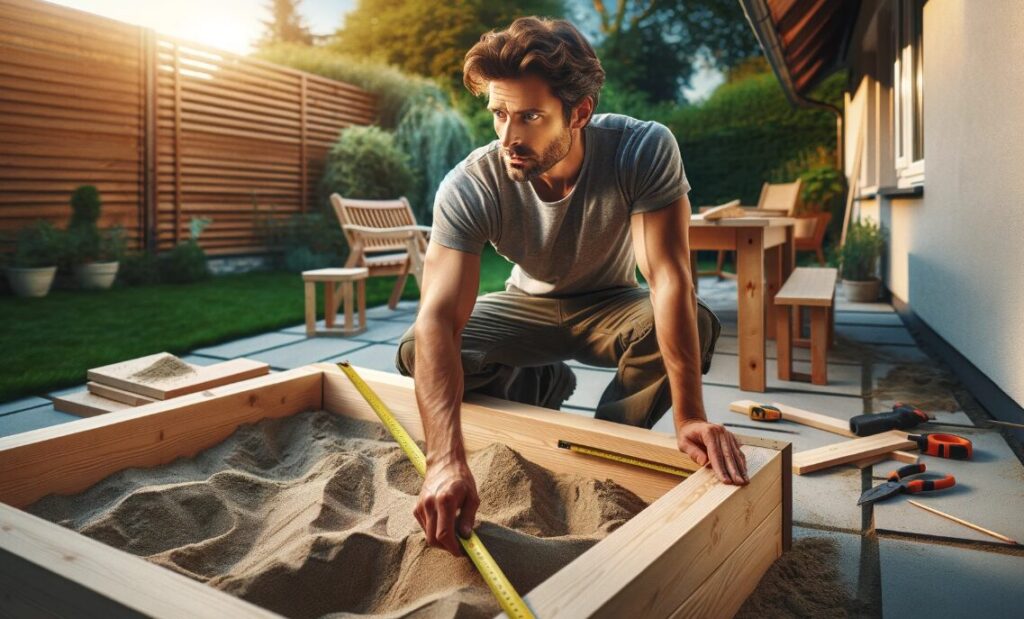In the world of home construction and DIY projects, few activities bring as much joy and satisfaction as building a sandbox for the little ones. Not only does it encourage outdoor play, fostering imagination and physical activity, but it also offers a hands-on project for the DIY enthusiast. There’s something inherently rewarding about creating a space where kids can dig, build, and explore right in their backyard.

Choosing the Right Location
Before you break ground or saw wood, selecting the right spot is crucial. You’re looking for the Goldilocks zone: not too sunny, not too shady. A place where the kids can play without turning into lobsters under the harsh sun, but with enough light to keep the chills at bay. Also, think about drainage. You don’t want your sandbox turning into a mini-lake after a downpour. Suss out a spot where water can drain away naturally. Lastly, safety first. Keep the sandbox in view of the house but away from foot traffic and any potential hazards.
Materials and Tools Needed
Here’s your shopping list. It’s straightforward but essential for getting your sandbox off the ground—literally.
- Materials:
- Wood: Cedar or redwood are your best bets for durability and rot resistance.
- Sand: Play sand, specifically. It’s cleaned and processed to be safe for kiddo contact.
- Landscape fabric: To keep weeds at bay and improve drainage.
- Screws: Stainless steel or coated, to stand up to the elements.
- Optional: Weed barrier, for under the sandbox, and a tarp or custom cover.
- Tools:
- Circular saw or handsaw
- Power drill with screwdriver bits
- Tape measure
- Carpenter’s square
- Level
- Staple gun (for the landscape fabric)

Designing Your Sandbox
When it comes to dimensions, think about the space you’ve got and how many kids might be playing. A 4×4 or 5×5 feet square is a good start for a couple of toddlers. If you’re looking at hosting half the neighborhood, maybe scale up.
Now, about keeping critters out and making maintenance easier, a cover is non-negotiable. You can get creative here—hinged wooden covers that double as seats when opened, or a simple tarp cover for those on a budget.
Speaking of seats, built-in benches are a win-win. They provide a place for the kids to sit without getting sand in their shoes (or everywhere else), and they add structural integrity to the sandbox. You can incorporate these into the corners of the frame or have them fold out as part of a smart cover design.
Step-by-Step Building Guide
- Preparing the site. First things first, you gotta pick your spot like a pro—think about drainage, sun exposure, and how it blends with your yard. Clear the area of any debris, rocks, or roots. Use a shovel and a rake to get the ground as level as possible. It’s all about having a solid foundation, even if it’s just for play.
- Constructing the frame. Grab your materials—cedar or redwood’s your best bet for the long haul because they’re rot-resistant. Measure twice, cut once. You’re aiming for a sturdy frame that can hold a bunch of sand and a couple of rowdy kids. Assemble it with deck screws for extra durability. Toe-nail the corners or use metal brackets if you want to keep things extra tidy.
- Laying the foundation (optional landscape fabric). If you’re not keen on weeds making their way into the play area, roll out some landscape fabric at the bottom of your frame. It’ll let water drain but keep the weeds out. Staple it to the sides of your frame to keep it in place.
- Filling with sand. Now, for the fun part—sand! Go for play sand, which is cleaner and safer for the kiddos. How much? Well, that depends on your sandbox size, but you’ll want at least a 6-inch depth for decent play. Spread it evenly and rake it out smooth.
- Adding features (cover, seats). A cover’s not just about keeping the neighborhood cats out, it’s about keeping the sand clean and dry. You can DIY a simple wooden cover or get fancy with a retractable one. And don’t forget about seating—built-in benches or even just a couple of sturdy logs can make a world of difference for comfort.
Finishing Touches
- Sand toy storage ideas. Get creative with storage solutions. A small deck box or a hanging net bag can keep those sand toys tidy and ready for action.
- Decorative elements to match your backyard décor. Let your sandbox blend in or stand out. Paint the exterior, add some fun flags, or surround it with flower beds to make it a real feature in your yard.
Maintenance and Safety Tips
- Keeping the sandbox clean and safe for play. Regularly rake the sand to keep it fresh and to spot any unwanted debris or sharp objects. Keep it covered when not in use to maintain cleanliness.
- Periodic checks for wear and repairs. Wood can weather and screws can loosen. Make it a habit to inspect and tighten things up as needed. Safety first, fun always.
FAQ Section
It’s all in the math—length x width x desired depth. A typical 5×5 sandbox with a 6-inch depth will need about half a ton of sand. Don’t skimp on depth, more sand equals more fun.
Stick with play sand. It’s been washed and processed to remove dust and other nasties, making it safer for the kiddos.
A solid cover is your best friend here. Make it part of your nightly routine to cover up, and you’ll keep the critters at bay.
Absolutely. A canopy or a sunshade can make the sandbox a cool spot on hot days. Plus, it adds a bit of style to your setup.
General rule of thumb—give it a good once-over annually. Replace it if you start seeing too much debris, or if it just seems “off.” Better safe than sorry when it comes to playtime.
